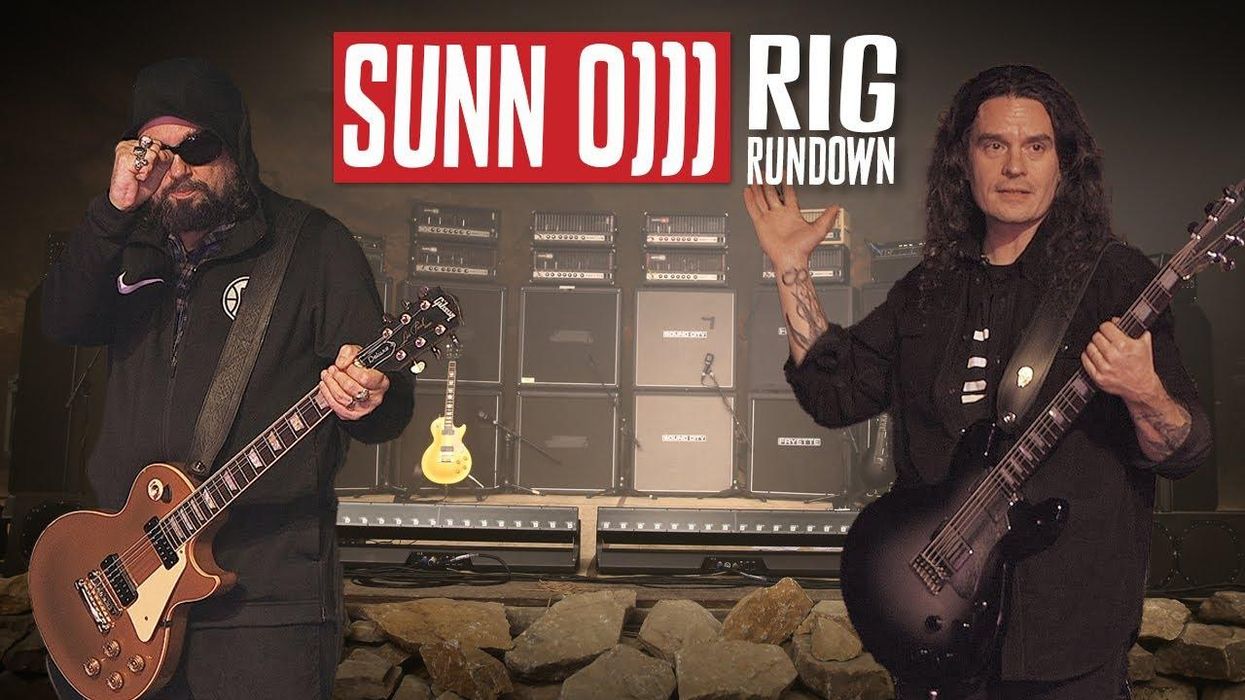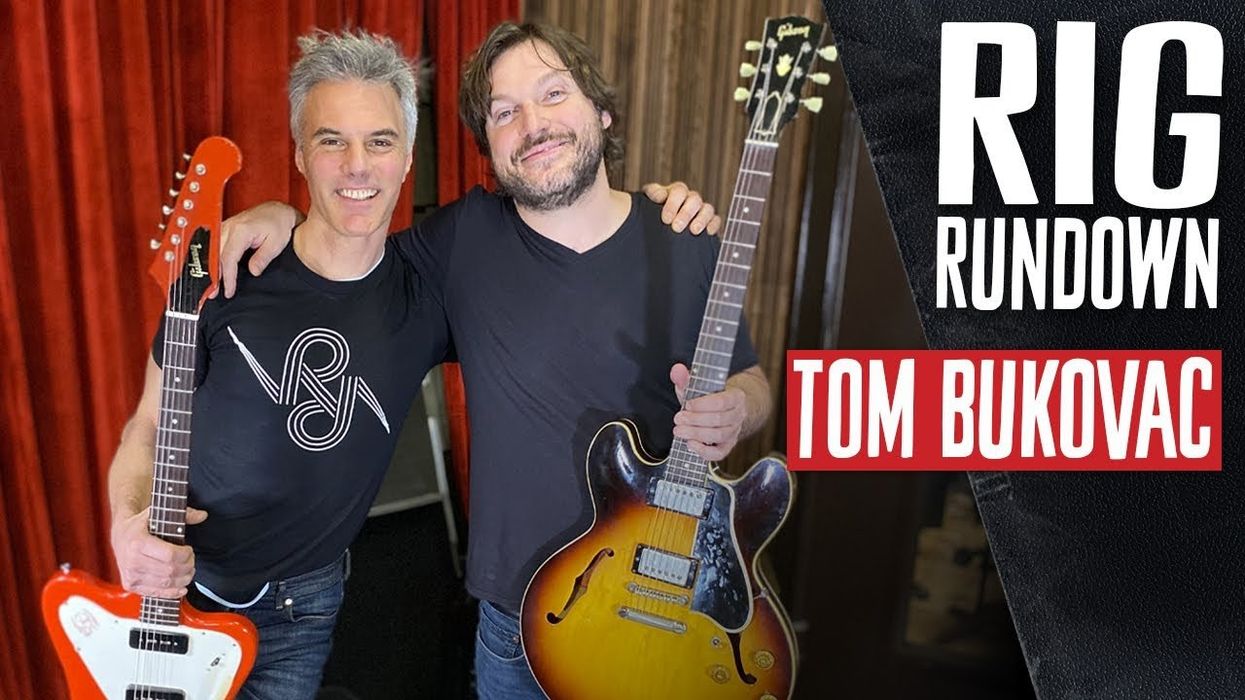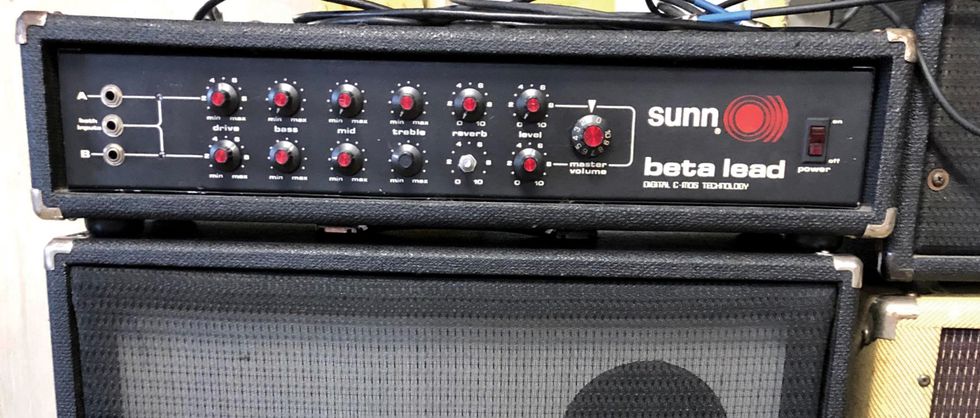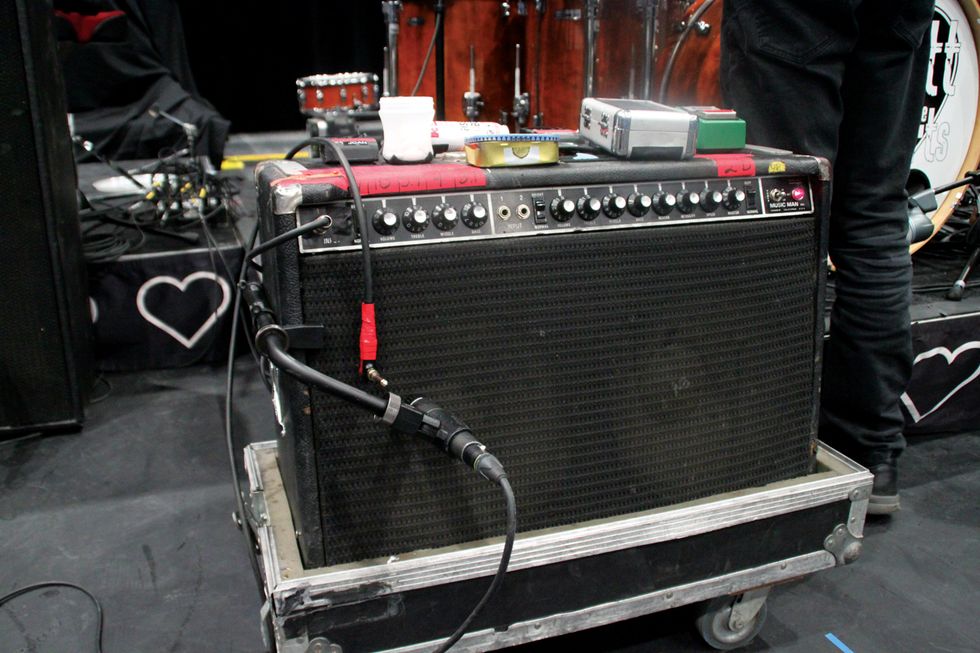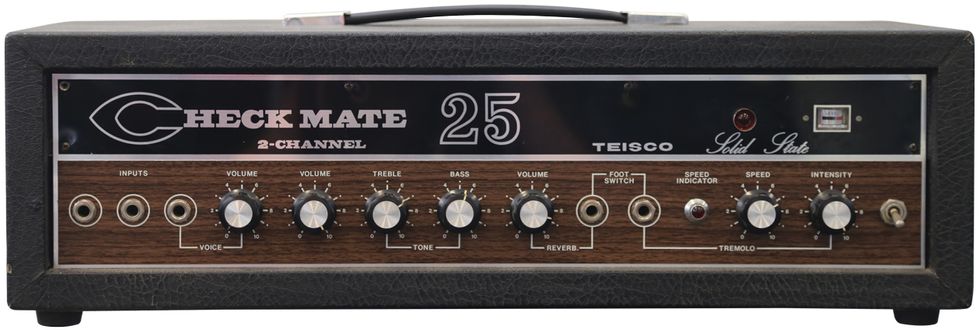Witness drone metal overlords Stephen O’Malley and Greg Anderson pack and rattle a cave with two guitars, 14 amps, 16 cabinets, and 19 pedals to test the Earth’s crust.
We’ve featured loud rigs. We’ve stood strong in front of Matt Pike’s octet of Oranges, been washed over with waves of volume from Angus Young’s nine Marshalls for AC/DC’s “small gig setup” in an arena, trembled from J Mascis’ three plexi full stacks, and even withstood Bonamassa’s barrage of seven amps at the Ryman, but nothing prepared us or compared to the Godzilla-rising-from-the-Pacific roar that is Sunn O)))’s auditory artillery. And it’s more than the sheer sight of 14 amps and 16 cabs or the dishing of deafening decibels; it’s the interplay of these characters and their conductors.
“The third member of the band is the amplifiers!” laughed Greg Anderson in a 2014 interview with PG. “We use vintage Sunn Model Ts from the early ’70s. They’re a crucial part of the show. I’ve got more amps than I have guitars.”
Stephen O’Malley takes a more metaphysical outlook to the connection between him and the thundering Model Ts. “My philosophy is that I’m just part of this bigger circuit of the instrumentation,” he says. “You have, of course, the amplifier valves, the speaker, effects pedals acting like different and various voltage filters, the air in the room, and the feedback generated from all this equipment, so who’s in the band is immaterial.”
We learned more about O’Malley’s perspective when, following a 90-minute drive southeast from Nashville to Pelham, Tennessee, and a short descent into The Caverns, the Sunn O))) guitar tag team welcomed PG’s Chris Kies onstage for an amplifying chat. O’Malley details his signature Travis Bean Designs SOMA 1000A, while Anderson explains how a broken guitar led him to his beloved Les Paul goldtop. Both pay homage and reverence to the eight Sunn Model Ts that form the band’s foundational tonal force, and explain why the LM308-chip Rat influenced their Life Pedal collaboration with EarthQuaker Devices.
Special Silver 25th anniversary edition of the V.3 Life Pedal
Sunn O)) Official Website
Brought to you by D’Addario XPND Pedalboard.
Silverburst Slugger
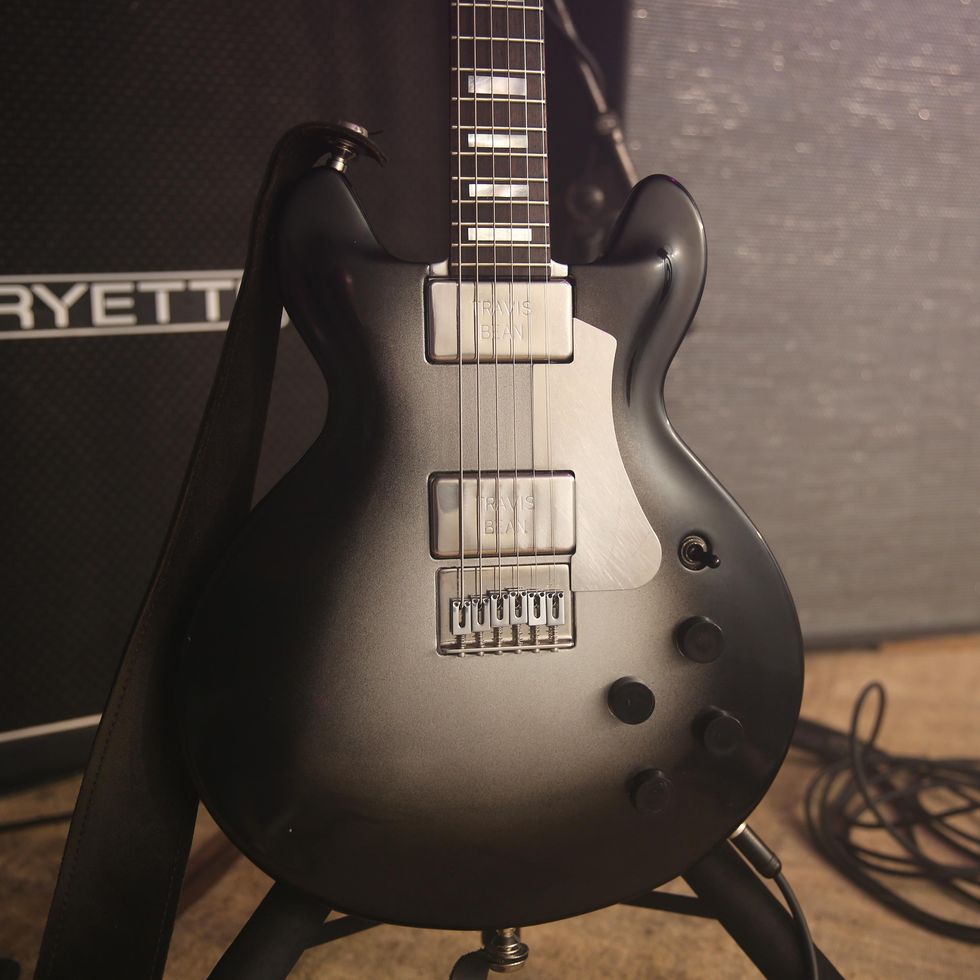
This is Stephen O’Malley’s signature Travis Bean Designs SOMA 1000A that he co-designed alongside Electrical Guitar Company’s Kevin Burkett and late luthier Travis Bean’s wife, Rita Bean. Burkett revitalized the brand in the early 2010s with the guidance of Rita and Travis’ longtime business partner Marc McElwee.
First off, just like the original TB models, these feature a single piece of 7075-T651 aluminum alloy that runs the length of the guitar’s backside that makes up the headstock, neck, and the rear half of the body. Its scale length is 25.5", the neck radius is 12", and it has a brass nut set for the band’s use of A tuning. The handwound high-gain TB humbuckers are built to Stephen’s specs. The build includes CTS pots, Sprague caps, and Switchcraft hardware. The silverburst finish covers a koa body.
Stephen’s thoughts on the collaboration: “Being honored with a signature model is great, but the bigger achievement or accomplishment is having an interaction with Kevin and the Bean family, who produced an instrument we’re all proud of.”
Strong T
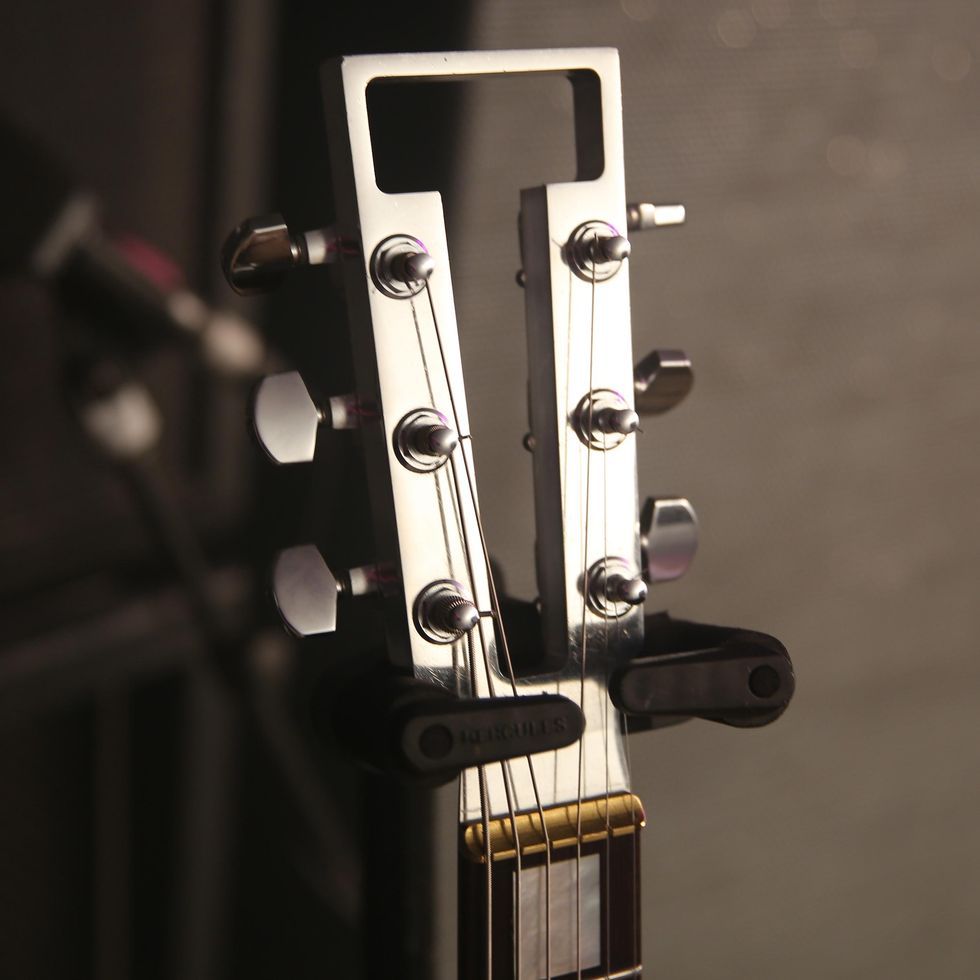
Here’s the standard eye-catching T headstock and brass nut featured on all old and new Travis Bean instruments.
Stephen’s Specter
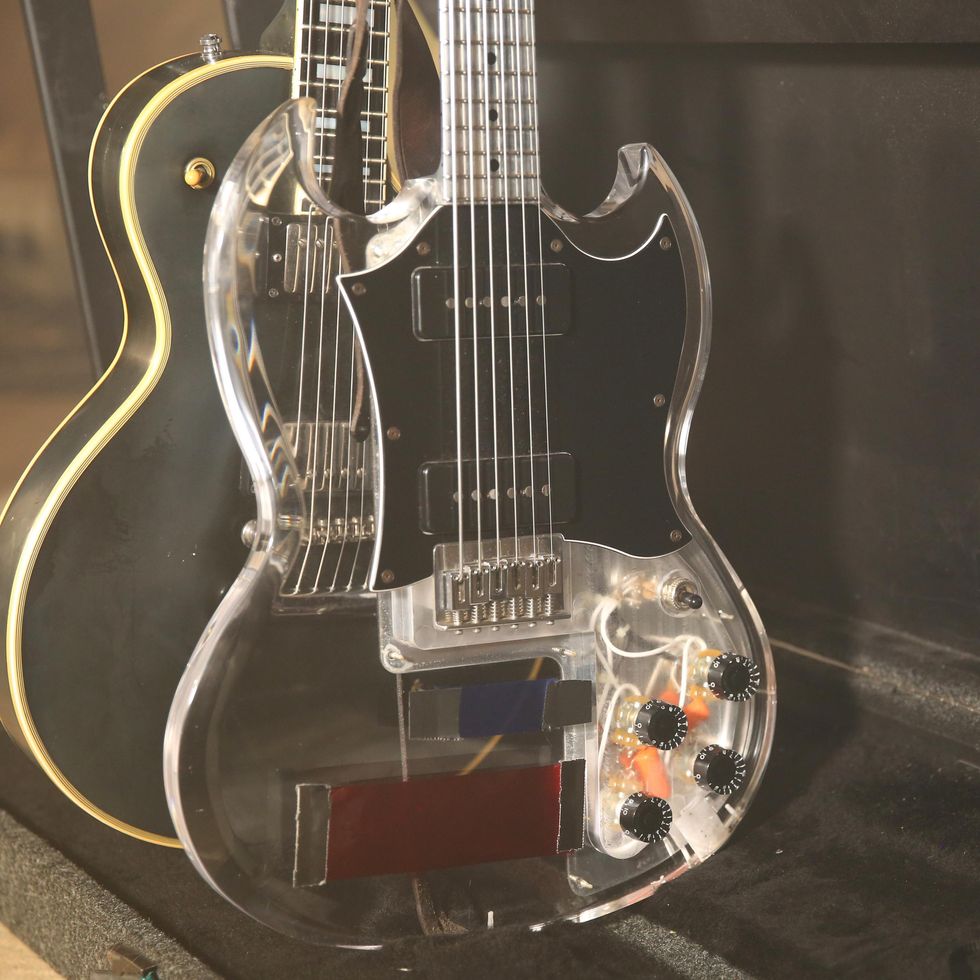
This transparent devil is an Electrical Guitar Company Ghost that has a 1-piece aluminum neck that covers backup duties for O’Malley. Fun fact: this has the same pickups in it as Steve Albini’s high-output single-coils in his Travis Bean Designs TB500 signature. They are RWRP (reverse-wound, reverse-polarity) to reduce the 60-cycle hum.
Greg’s Lucky Goldtop
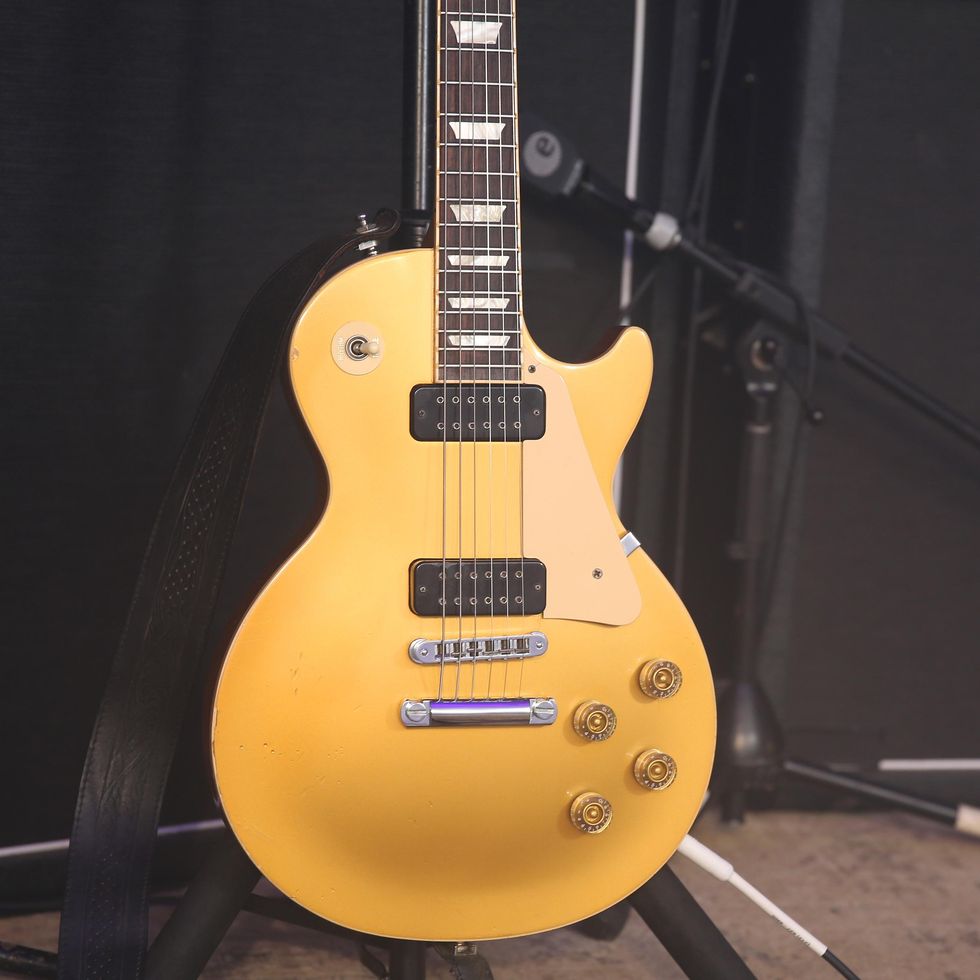
While touring with Boris in 2008 or ’09, Greg’s main 1989 Gibson Les Paul goldtop endured a neck fracture. On their next day off, he wandered into the nearest Guitar Center and walked out with the above 2005 Gibson Les Paul Deluxe. It originally had mini humbuckers, but Anderson felt they were “thin-sounding.” So, he swapped them out for a set of DiMarzio P90 Super Distortions, that are actually humbuckers housed in P-90 enclosures for replacements that don’t require routing. He loves the violent output and grind provided by the P90 Super Distortions.
Sonic Protagonists
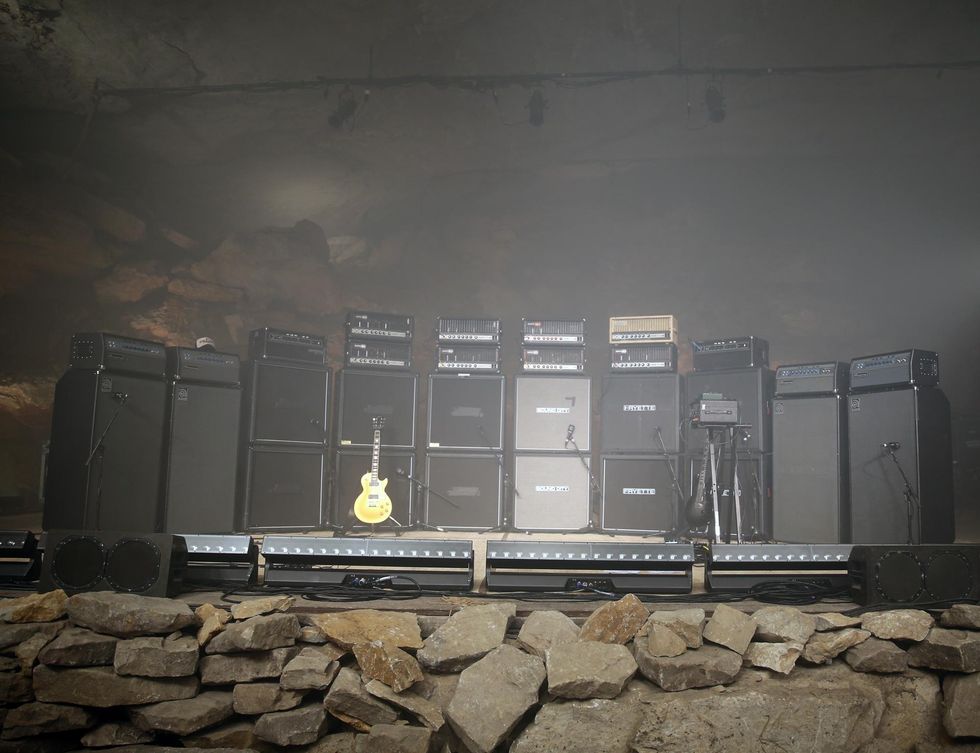
“The amps are certainly the main characters of the band,” concedes O’Malley. The main protagonists for Sunn O)))’s sonic saga are the eight Sunn Model T heads they set onstage. (Six are on and plugged into, while each member has a dedicated backup.) Stephen mentions in the Rundown that he prefers lower-wattage speakers, but when requesting backlines or renting gear from SIR, they can’t be too picky with the vast amount of cabinets they need. O’Malley runs his Model Ts and ’80s Ampeg MTI SVT through either 4x12s from Sound City or Fryette. The silver-panel Ampeg SVT-VRs flanking both ends of the semi-circle, are being slaved by each member’s MTI SVT, and that signal is hitting their matching Ampeg Heritage SVT-810AV cabinets outfitted with 10" Eminence drivers.
Stephen O’Malley’s Pedalboard
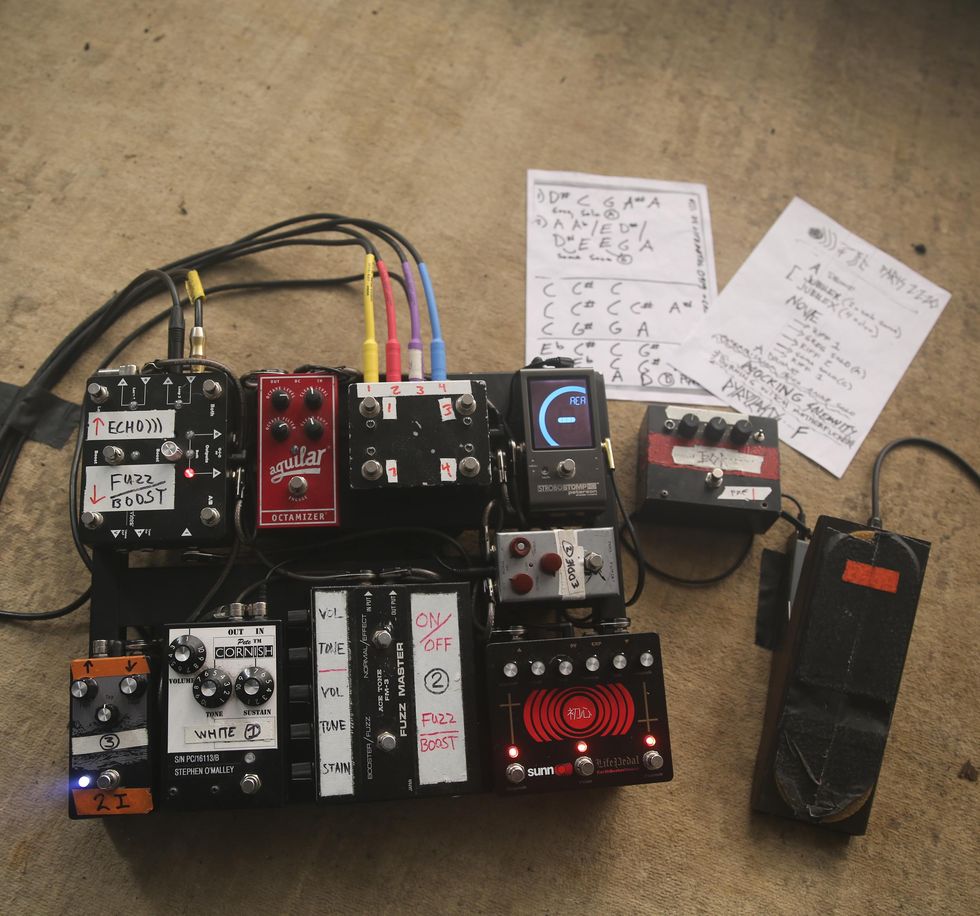
“My concept in playing this music for tone involves many, many, many different gain stages that are all intonated differently depending on the pitch of the sound. There are slight shades of color saturation or grain as if it’s a paint—the shorter bandwidth color gradation or the density of the paint.” All these subtle sweeps of saturation, sustain, and feedback are enlivened and exaggerated with Stephen’s pedal palette. His current collection of slaughtering stomps include the band’s most recent collaboration with EarthQuaker Devices (Life Pedal V3), an Ace Tone FM-3 Fuzz Master, a Pete Cornish G-2, and an EarthQuaker Devices Black Ash. For subtler shadings, he has a J. Rockett Audio Designs Archer.
The EQD Swiss Things creates effects loops to engage the FM-3, G-2, or the Black Ash. In addition, he runs a Roland RE-201 Space Echo through the Swiss Things, too. O’Malley uses the Aguilar Octamizer as a “fun punctuation that comes on once in a while. It abstracts the guitar into minimalist electronics [laughs].” The custom Bright Onion Pedals switcher keeps the amps in sync with phase controls and ground lifts. A Peterson StroboStomp HD keeps his Travis Bean in check. Off to the side of the board is a Keeley-modded Rat that initiated the band’s core sound, plus a Lehle Mono Volume. (Stephen is a Lehle endorsee.) This circuit includes the heralded LM308 chip and was the basis for their partnership with EQD and the Life Pedal series.
Space and Time
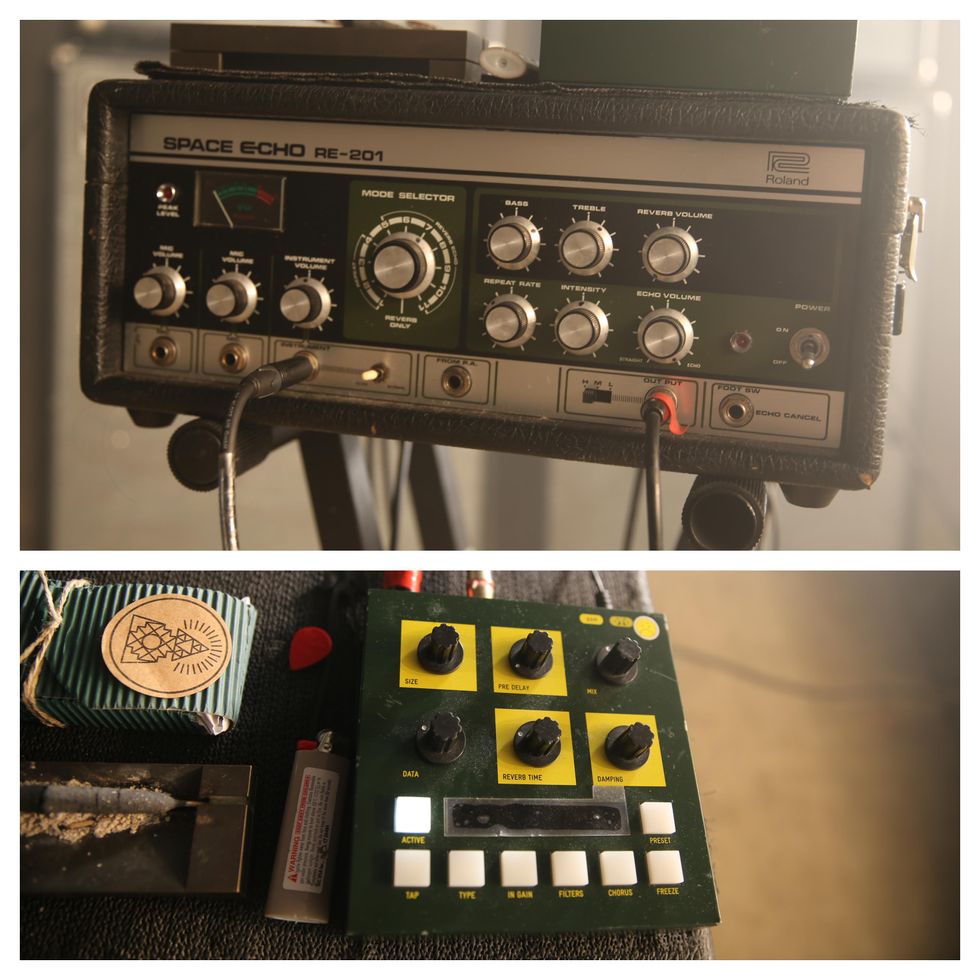
Elevated off the stage floor and secured by a stand are O’Malley’s Roland RE-201 Space Echo and Oto Machines BAM Space Generator Reverb.
Greg Anderson’s Pedalboard
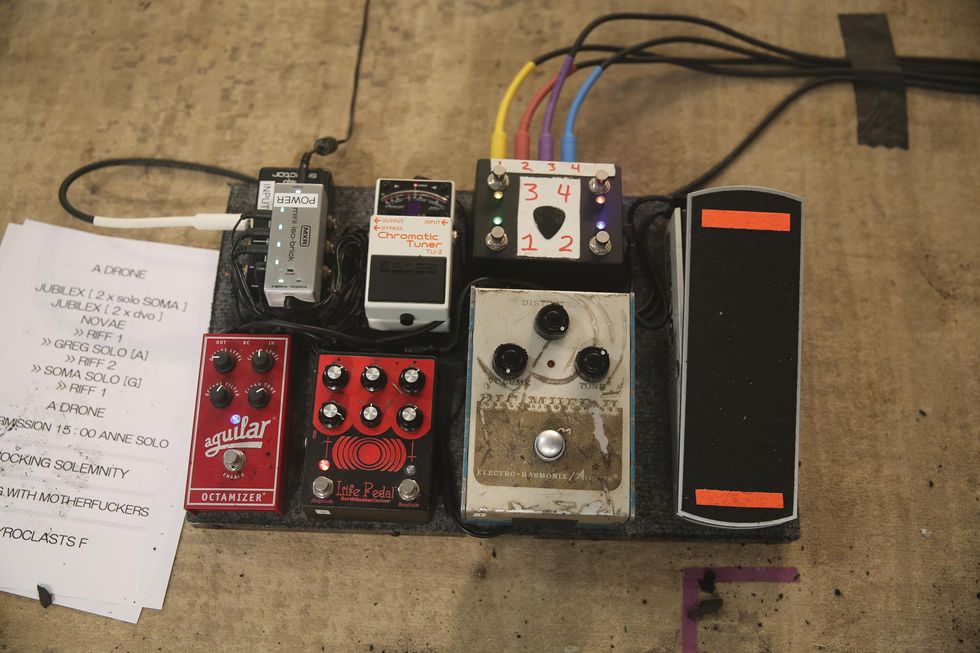
“To be honest with you, I try to keep it pretty simple now because I love pedals and have fallen down a lot of rabbit holes with them, but I found myself troubleshooting and having more issues than my sound warranted. When I started with this band, it was just a Rat and tuner pedal, so I try to just bring what I need,” says Anderson. He found a potent pairing with the EQD Life Pedal V2 acting as a boost and running into a vintage Electro-Harmonix Sovtek Civil War Big Muff that creates a “powerful, chewy, ooze” tone. Like O’Malley, he also has a custom Bright Onion Pedals box and an Aguilar Octamizer set to unleash a “ridiculous, beating, fighting, chaotic, sub-bass sound.” An Ernie Ball VP Junior handles dynamics, a Boss TU-2 Chromatic Tuner keeps his goldtop in shape, and an MXR Mini Iso-Brick powers his pedals.
When you’re one of the most recorded guitarists in Nashville, you make sure you can cover all the bases. Watch this in-depth look at the amazing vintage guitars, rare amps, and massive pedalboard that inspires one of Nashville’s first-call session players.
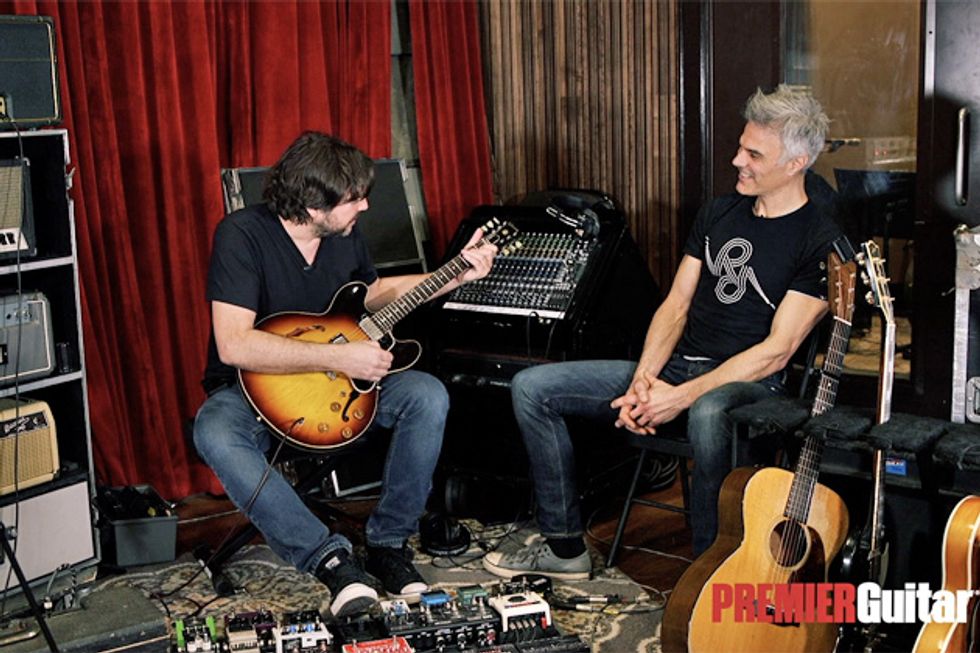
Tom Bukovac has recorded over 600 albums with artists as diverse as Steven Tyler, Carrie Underwood, Don Henley, Willie Nelson, Blake Shelton, Stevie Nicks, and Sheryl Crow. PG’s John Bohlinger caught up with “Buk” in his natural habitat, Blackbird Studios, where he was just finishing day one of a two-day tracking session for the new Gary Allan album.
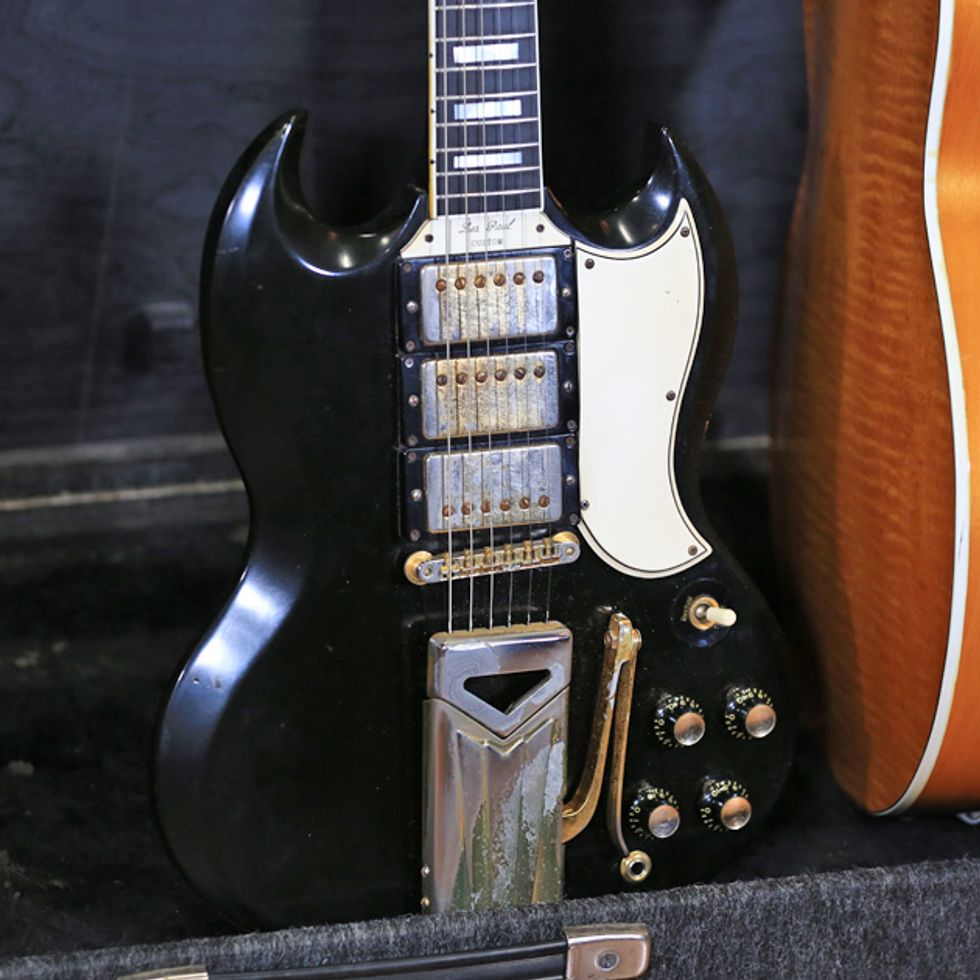
Because one never really knows what’s going to be needed on a session, Bukovac usually brings a lot of options. One favorite is this 1961 Gibson SG Les Paul in a custom factory black finish. It’s estimated there were only three of these made. This SG, like all of his electrics, stays strung up with D’Addario NYXL .010s.
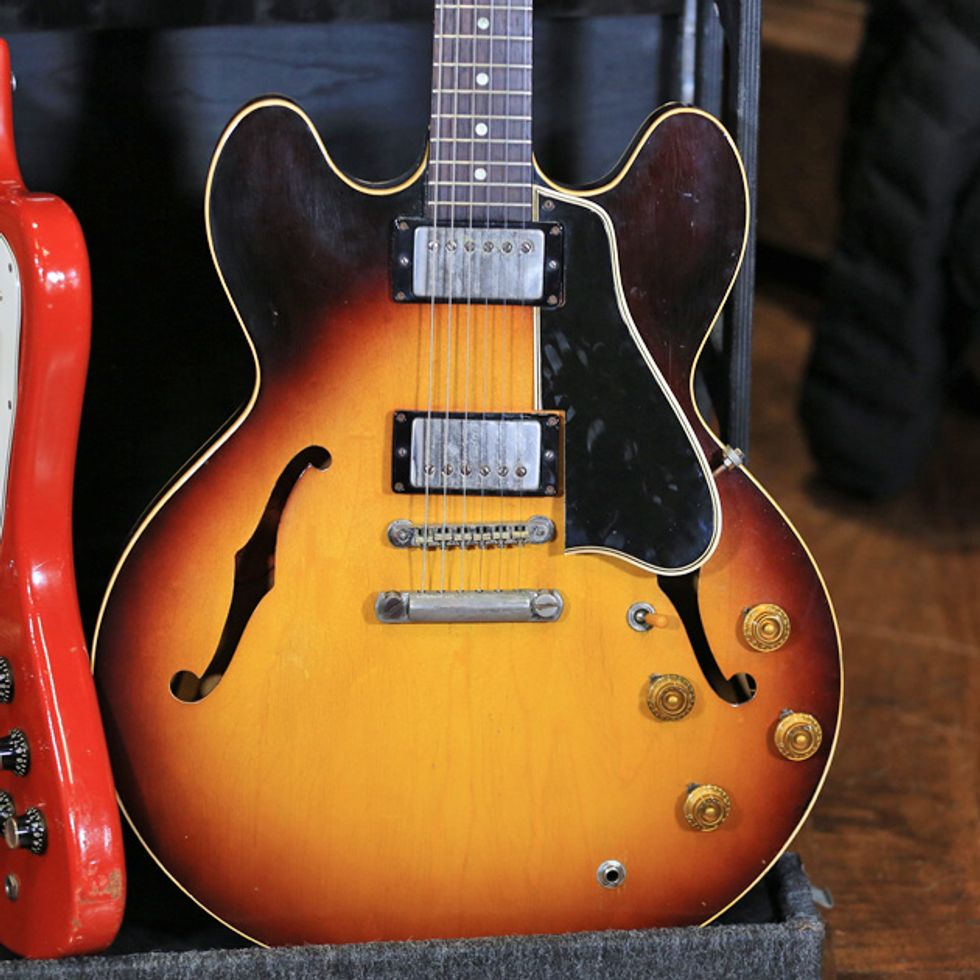
Bukovac is known as a 335 whisperer. His current favorite is this 1958 Gibson ES-335.
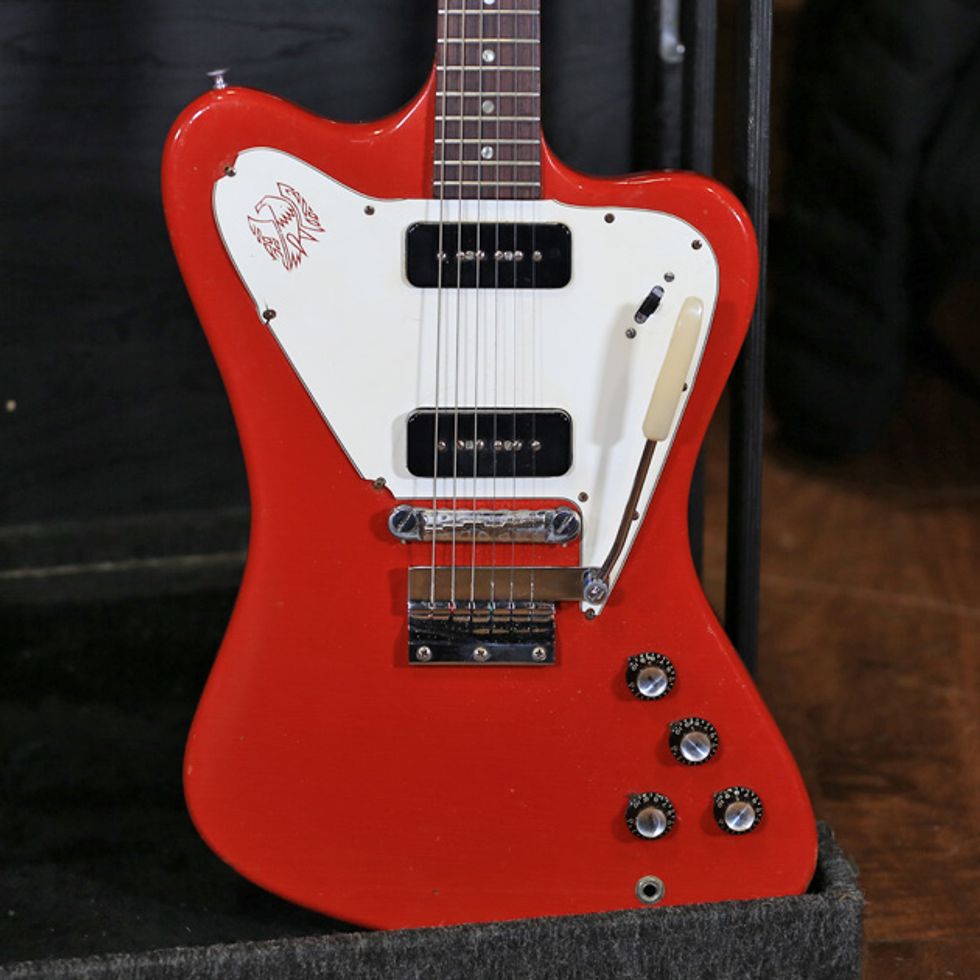
Bukovac’s 1965 Gibson non-reverse Firebird I features a very rare Ember Red finish that came straight from the factory.
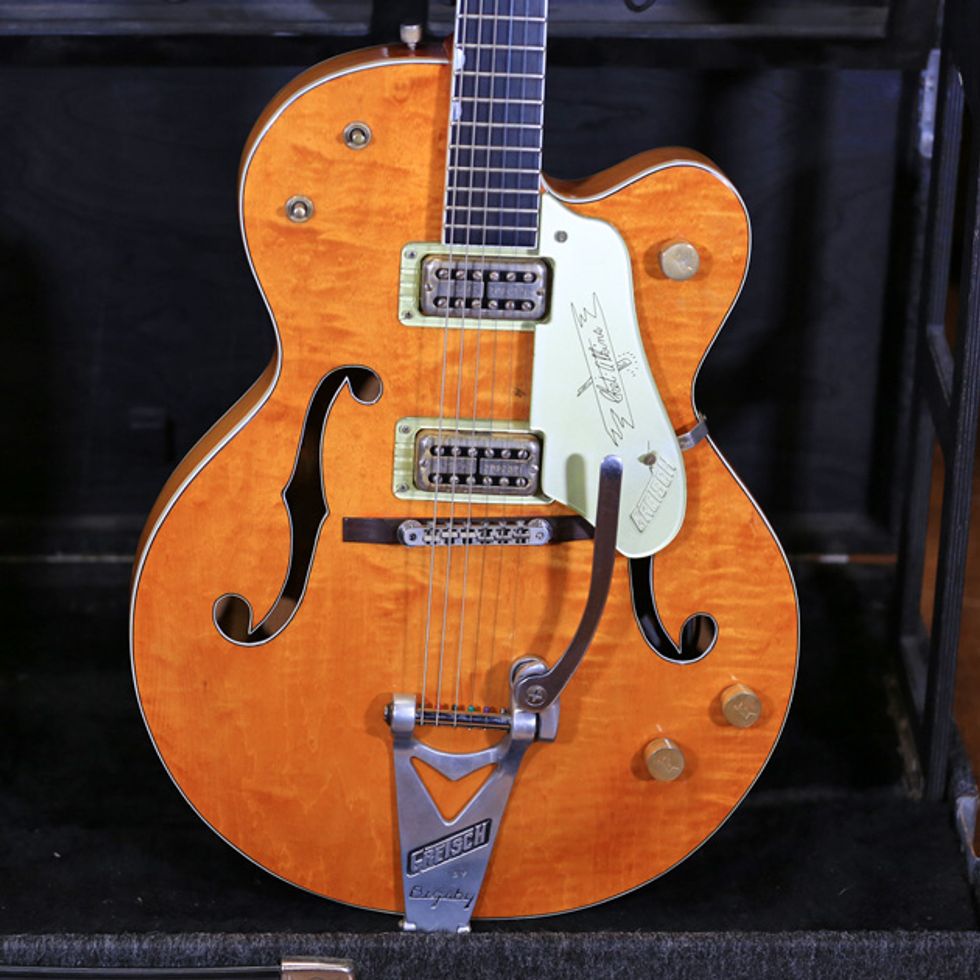
For some Bigsby goodness, Bukovac plays a 1961 Gretsch 6120.
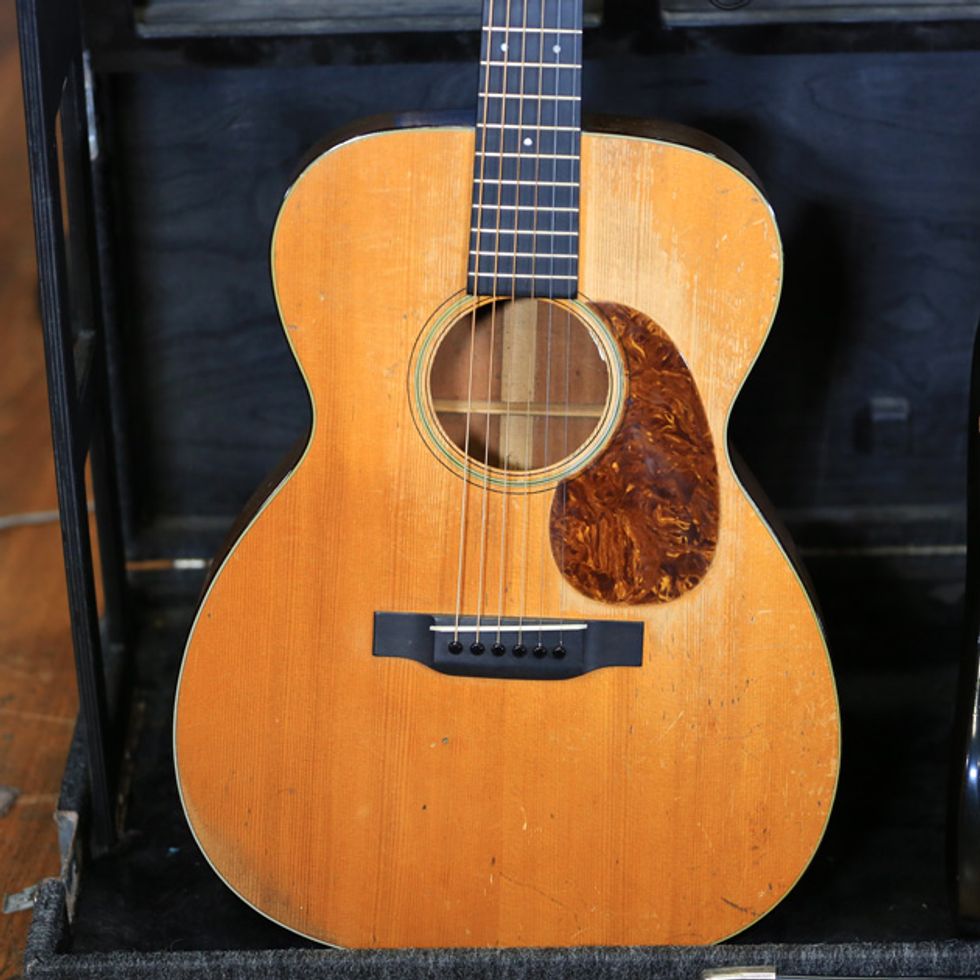
Bukovac reaches for this 1938 Martin OOO-18 strung with D’Addario .012s when he needs some acoustic vibes.
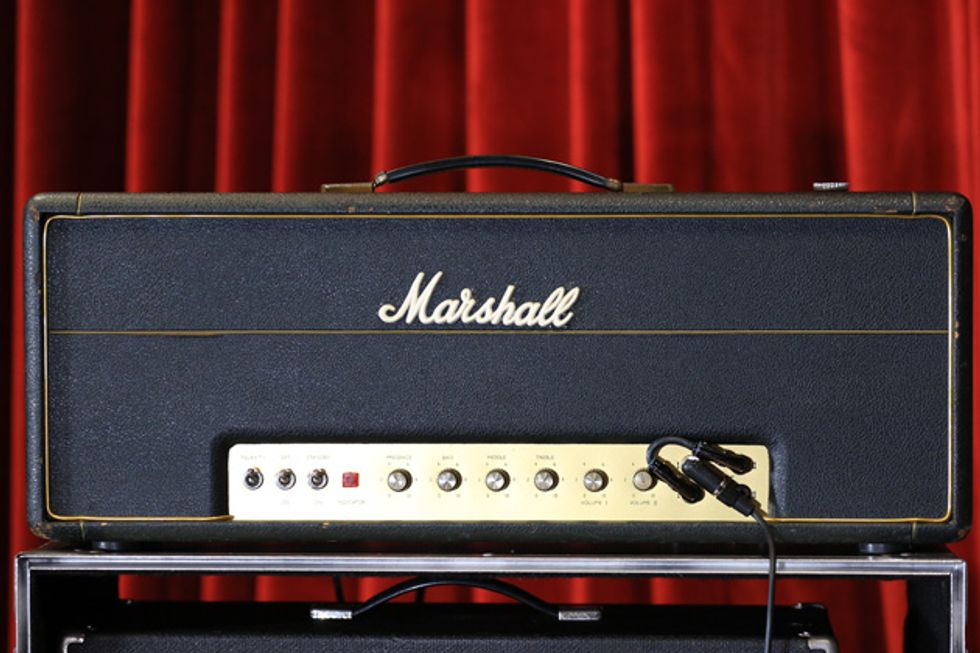
Buk typically carries four different amp heads on sessions. Each head can be switched to feed a Bogner 2x12 cab loaded with a pair of older Celestion 65 speakers. On the top of the amp stack sits this ’68 100-watt Marshall Super Bass.
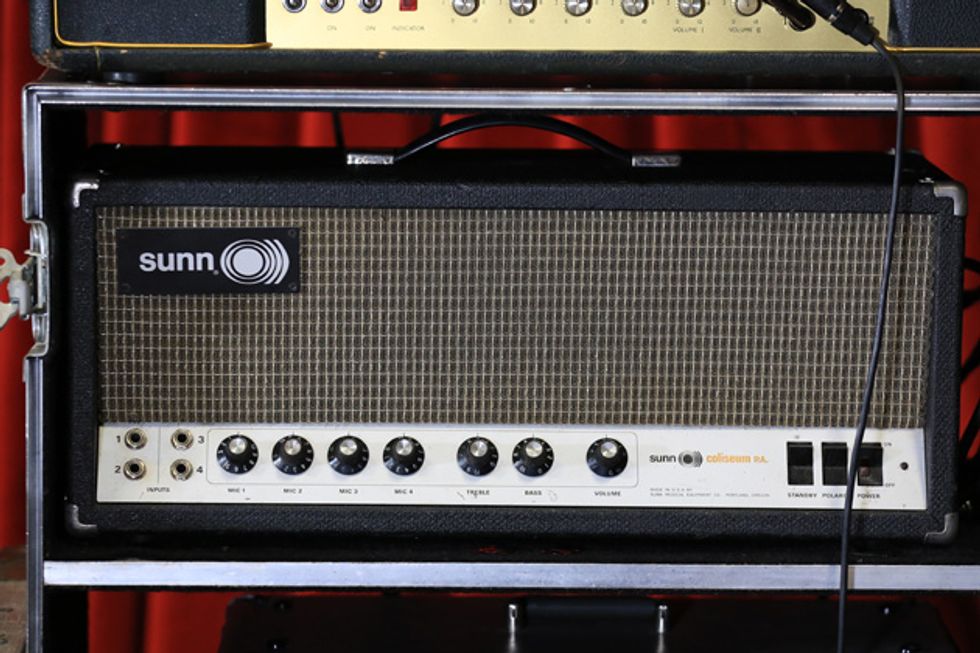
Next up is Bukovac’s rare 1968 Sunn Coliseum PA head. It’s the same model that was used by Leslie West on “Mississippi Queen.”
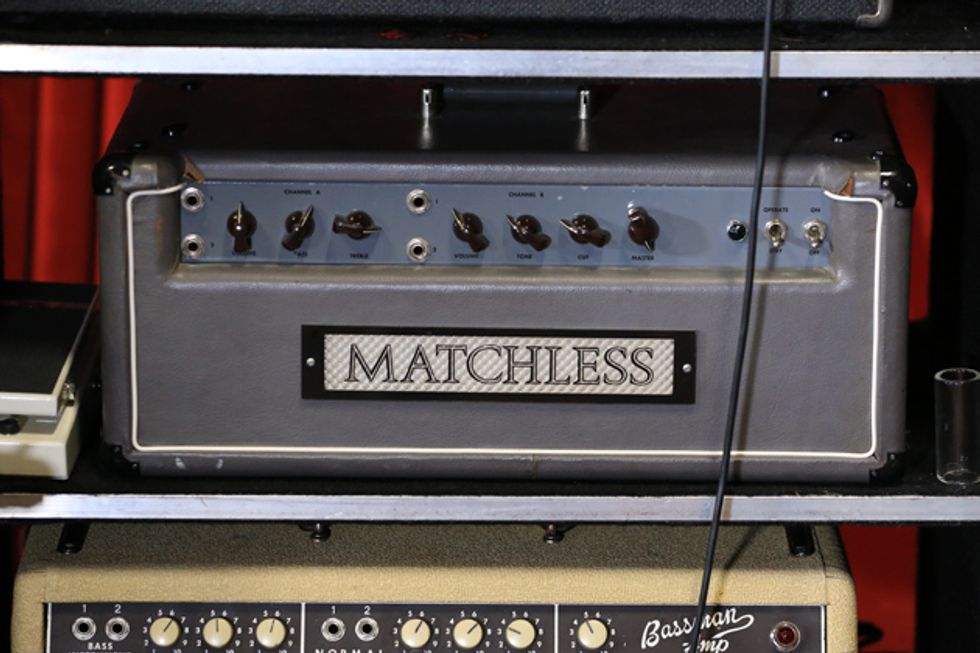
This 1990 Matchless HC-30 is one of Bukovac’s most prized amps. It was one of the first four Matchless amps that were made on founder Rick Perrotta’s kitchen table.
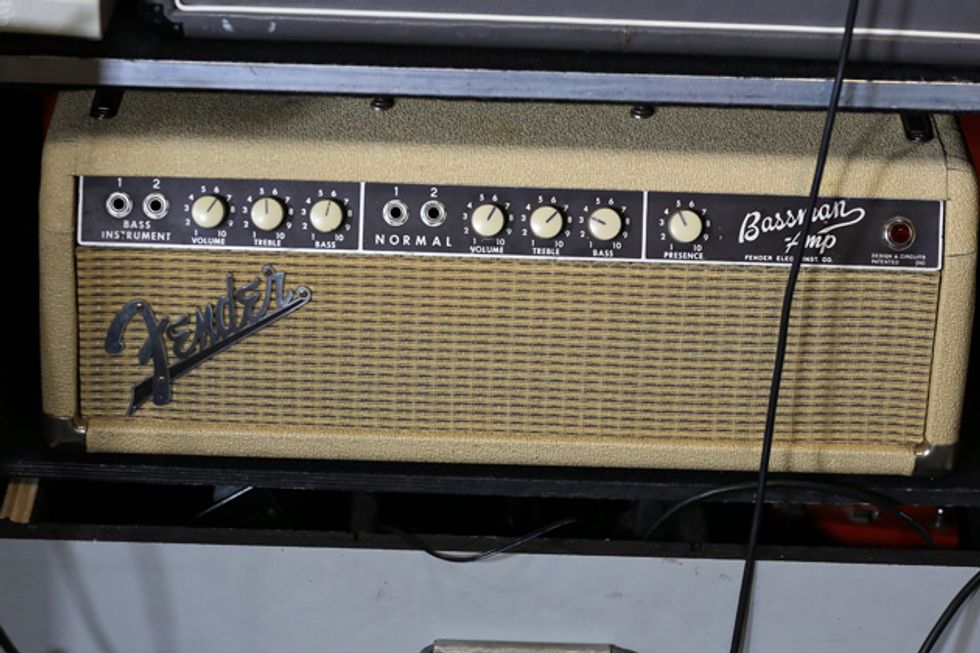
Last but not least is Bukovac’s 1962 Fender Bassman.
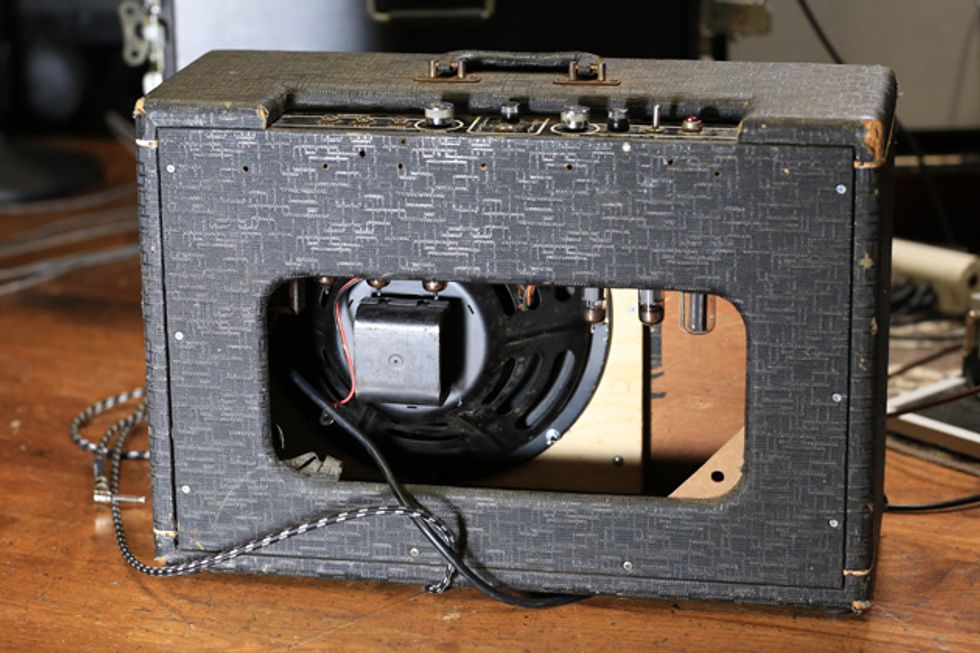
For a combo amp, Bukovac uses this 1960 Gretsch 6161. (This is the amp you hear throughout the Rundown.) Originally the 6161 came with two oval 6" by 9" speakers and a tweeter, but the previous owner switched it to a single 12".
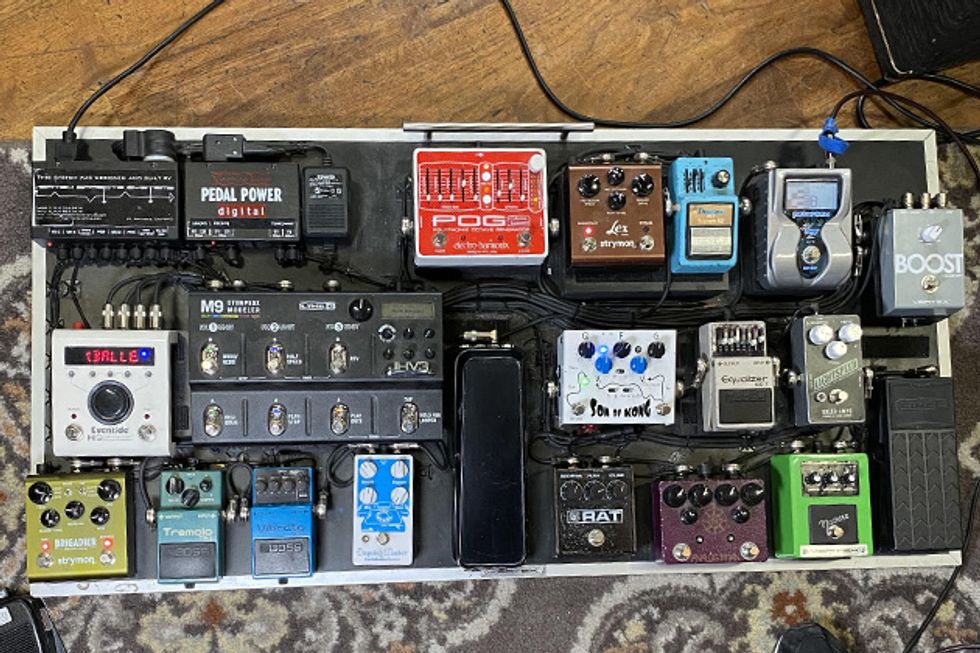
Barry O’ Neal at XAct Tone Solutions built this and several of Bukovac’s other pedalboards. Essentially, the board is divided into two sections: gain and effects. The gain section includes a Vertex Boost, (connect to a Dunlop expression pedal), a rehoused Nobels ODR-1, an Analog Man King of Tone, an old ProCo Rat, a Greer Lightspeed and a Spontaneous Audio Son of Kong. On the other side of the board, there is a Boss GE-7, an Ibanez PQ-9, an EarthQuaker Devices Dispatch Master, a Line 6 M9 with a JHV-3 mod, a Strymon Brigadier, a Strymon Lex, an Eventide H9, an Electro-Harmonix POG 2, a Boss VB-2, a Boss TR-2 with a Robert Keeley mod, and a TC Electronic Polytune. Bukovac also carries a few drawers of extra pedals that he subs in if it fits the songs, such as a Collision Audio Devices Black Hole Symmetry, a 1973 EHX “Ram’s Head” Big Muff, and more.
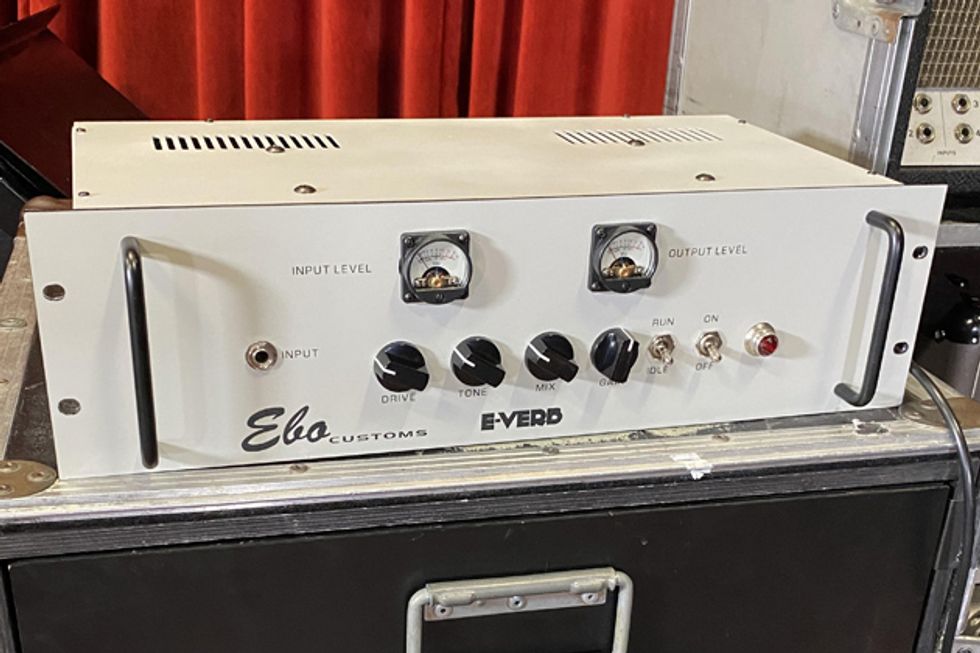
The last piece in Bukovac’s signal path is this Ebo Custom E-Verb built by local musician and amp builder Eric Borash.
Greg Voros and all the guys at Gruhns
Nick Drushel and all the guys at Glasers
Eric Borash at Ebo Customs
Barry O’ Neal at XActone
Silicon sluggers with brains and brawn for stage and studio.
As a lover of sound, I'm guilty of tunnel vision when it comes to guitar and bass amplifiers, often emitting a low groan when I arrive at a stage with backline gear not to my liking. It's discriminatory and, in fact, my judgmental eyeballs do this with almost every object on the planet.
So, I decided it's time to make an attempt to break out of my comfort zone and preconceptions, and let my ears decide what's best for a given stage or studio situation—while giving my biased peepers a rest. To help me get a fresh perspective and possibly reinvent my concept of what sounds good, I enlisted two colleagues, Jamie Stillman and Ben Vehorn of EarthQuaker Devices, to shed a little light on my otherwise dark and singular path. I also work at EarthQuaker, and I'm a pedal and amp builder. Jamie is the genius behind some of the coolest effect pedals out there, while Ben has worked in studios for years, earning a unique perspective on the audio-capture end. I also enlisted a half-dozen intriguing examples of vintage transistor titans and tiny terrors. Our goal: to open my heart and mind—and maybe yours, too—to some great sounding solid-state amps.
Enter the Wayback Machine
Before we get cracking, let's take a trip back through time to get some footing in amplifier topologies. In 1906, Lee de Forest—the self-described “Father of Radio"—improved the basic valve diode by including a separate, third electrode, thereby inventing the main building block of early tube amplification. Fifteen or so years later, this starts getting called the “triode," sensibly enough. Sounds science-y and cool, right? And as we approach the middle of the 20th century, the pentode (with five working elements) starts to show up and becomes a mainstay in the world of vacuum tubes. These new devices were perfect for the requirements of wartime, with lower manufacturing costs and greater versatility. They were also great for amps, because with each new element in the tube, bandwidth, tone, and feel characteristics improved.
Then along came transistors. The first patent for a transistor was issued in 1925, but things began to get serious in '47, when Bell Labs in New Jersey started experimenting with germanium crystals made in a lab, and discovered their ability to create output power greater than their input. That led to the first practical transistors for mass-production, based on those lab-cultivated crystals. (Yep, that's right. Fuzztone was born in a petri dish!)
Bell Labs was quick to slap a patent on this new wonder, and the first transistor radio appeared in 1954 with germanium diodes—the first solid-state semiconductors on the scene—inside. Later, as with tubes, a third electrode was added to the mix, and the germanium transistor you know from “Purple Haze" was born.
One commonly known limitation of germanium transistors is temperature instability. They get hot and start performing shoddily with regards to linearity and gain. To combat this phenomenon inherent to germanium, silicon was used for its abundance and better performance characteristics under metaphorical fire. Silicon is also the second-most-copious element on Earth, next to oxygen. And it conducts electricity excellently, and that only gets better with heat. Silicon transistors operate by passing electrons through a solid material—silicon crystals—which act as a semiconductor. Sometimes silicon transistors are referred to affectionately as “sand-state" because sand is composed of silicon. Tubes are sometimes referred to as “hollow-state" because they are either gas-filled or—like amp tubes—have a vacuum inside. This open space is where all the aforementioned elements of the tube do their magic.
Once silicon became the new champion of transistors, solid-state amplifiers were off and running. In fact, solid-state became the go-to status for all kinds of products. Another appealing advantage of solid-state technology is that it requires much lower operating voltages than high-voltage, high-impedance tubes. The low-impedance signals typically spit out by transistors are also great for driving low-impedance speakers, while tubes need an output transformer to take the tubes' high-impedance output and match the signal with speakers.
Since solid-state amps don't need an output transformer, they have a much lower weight than tube amps. That's a win for maker and end-user alike. The power transformer is also slimmed down. Since transistors operate at much lower voltages, they make it easy for lightweight power transformers to supply the DC voltage to fire up an amp.
Think of it this way: The wall at my house puts out 117 volts AC. To feed the tubes, I gotta step that voltage up inside the amp at least a couple of times to get what I need. That takes a big power transformer. Then there's the heater winding of the tube amp power transformer, adding yet more weight. But a solid-state amp is taking the 117V AC from my wall and stepping it down to around 50V DC after rectification. This less taxing exchange typically makes the power transformer smaller in solid-state amps. So, the less iron an amp has inside, the easier it can be lifted.
This simpler construction also means less can go wrong. And solid-state amps also have less of a shock hazard. Tube amp operating voltages are significantly higher than what exits in the wall, and they have high levels of DC voltage, which can really zap you and keep zapping you, since there is no rise and fall through the zero crossing, which happens with the AC voltage that powers solid-state designs.
That Other Tube Bias
So cool—those are the basics. What about the differences in sound?
Tube amps are said to be “warmer" and solid-state (aka transistor) amps are typically called “flatter." When I ask most of my pals about the sonic differences between tube and solid-state amps, that's the consensus. But why have these generalizations become common?
I think it stems from each device's saturation characteristics. Tubes are slow and unpredictably predictable—the way a tube distorts and produces harmonic non-linearity, the way it interacts with other tubes later in the circuitry. Transistors, on the other hand, take what you give them and barely wince. They do a tip-top job of not imparting additional color to the sound going through them. They are also much faster devices than tubes, which translates to a more immediate sound and feel. This isn't to say that tubes and transistors can't sound just like one another, because they totally can and often do! If you give musicians a blind listening test of different tube and transistor audio circuits, there's gonna be some crossover in the answers. Well, at least in my own.
But generally speaking, I'm with the crowd on the difference-in-sound debate. If I want a pushed guitar sound that only gets more unhinged as I crank the amp up, it's tubes. If I want a balanced, even sound for my new guitar no matter what venue I'm in and where the volume knob is set, that's solid-state.
It's not really this cut and dry. When considering your own options, use your ears to find your sound—even if it's just for today. You can always change amps again tomorrow.
So, armed with all that, let's bring one of our experts, Jamie Stillman, into the conversation.
Jamie Stillman's first solid-state amp was a '70s Sunn Beta Lead, a 100-watt monster with high headroom and booming lows, capable of handling effects geared for low-end sounds and running clean at high volumes. These days, Sunn Beta Leads in good condition sell for about $500. The Melvins' Buzz Osborne is a die-hard Sunn Beta Lead user.
When did you begin to discern the difference between tube and solid-state amps?
When I was playing drums in [Kent, Ohio-based '90s band] Harriet the Spy, I think Joel [McAdams, a fellow band member] had a Sunn Beta Lead. I was looking for a new amp. You could find those solid-state Sunn amps any day of the week for, like, 40 bucks. It just sounded better than the JCM900 I was using at the time. Back then I didn't really know what solid-state meant, I just knew it didn't have tubes. The benefit of solid-state amps is higher headroom before distorting. The Sunn had that. It also just had more low end. That's what I liked at the time. Then I sold those and got a Bassman head. After that I got a Music Man HD 130, and that's when I started really paying attention to amps. [Editor: Early-'70s Music Man HD-130s have a solid-state preamp with a 12AX7 phase inverter tube.]
Take me through your hybrid Music Man-era rig.
I don't remember how I found out about the Music Man. I think I was looking for something that sounded like a Fender, but would never distort—that I could just keep making louder. That is what totally drew me to it. You could run lower octaves at it and it wouldn't blow out or distort. Then you could just keep adding more and more boost to it and it would just get louder. I never had an issue with it not being loud enough. And that's what I think I do a lot of the time—just keep adding more and more volume.
Then it makes sense that you'd be expanding into higher headroom amps.
I know it's not a popular opinion, but I really like solid-state amps, a lot. But now, I'm using a Marshall Super Lead and a Sunn Model T—both tube amps—which totally goes against that.
Designed to compete with Fender's Twin Reverb, the Music Man HD-130 boasted 130 watts and four 6CA7 output tubes—a version of the EL34. But this '70s creation had a solid-state preamp circuit. In later models, the 12AX7 phase inverter tube was also replaced with solid-state circuitry. The result was an amp with lots of headroom and clarity, and it found favor with a diverse range of players, from Aerosmith to Mark Knopfler. Today, they are available as reissues, and vintage models start at about $700—and can run hundreds more—for a combo in good condition. This road warrior is owned by Joan Jett.
So what is the discernable timbral difference between tubes and solid-state for you? You mentioned headroom and bass extension.
I'd say the headroom. The one negative thing I'd say about solid-state is that it's flat. No matter how you EQ it, it kinda sounds dead.
Which can become increasingly apparent when you crank it up.
Yeah, I'd say so. As you may know, I made the Speaker Cranker [overdrive pedal] for the Music Man, in an attempt to make it not so flat.
For bass, I use a solid-state Ampeg SVT-450, and I love the way that amp sounds. It does what I want it to do: It sounds like Jesus Lizard.
What's the coolest-looking solid-state amp?
I like the '70s stuff. Acoustics look really cool. Some of those late-'70s Peavey amps look really cool too. They look like a '70s version of the future.
With all the class D and hybrid designs tumbling out these days, do you think there will be a boutique solid-state renaissance that harks back to those classic-era designs and the '70s aesthetic?
I'm shocked that nobody has done it. I mean, it's not easy, but the availability of parts is higher and the cost is lower. I think that if anyone were to make a solid-state amp look cool, you'd probably sell a ton of them—even if it's light, if it just looked like a regular amp. In the end, if you do a thing where you like to stack multiple gain stages, or if you're trying to get louder without compressing or distorting, a solid-state amp is totally the way to go. If you're looking for more defined sub-octave effects from your pedals, or for the pedals to sound more like themselves, solid-state is the way. It just sounds more pure. But I guess it all just depends on how you play.
As our conversation wound down, Jamie mentioned a little solid-state head that he liked primarily for its tremolo. So let's take a look at the Teisco Checkmate CM-25.
Checkmate model line came in a variety of wattages and in both tube and solid-state editions. A rare version of the CM-25, in rolled and pleated vinyl covering a two-speaker combo, could sell for $500 or more today, while a lower-wattage Checkmate 12 with a single speaker can be found in the $100 range. Yes, that's a tiny VU meter in the upper right corner.
Although the Teisco company is more famous for its electric guitars, the 25-watt Checkmate is no slouch. On its front panel, there are two instrument inputs with shared controls and a third input with its own volume control. The third channel is filtered for a bass-heavy sound. Volume, treble, and bass fill out the preamp dials. There's reverb and tremolo, with the latter having both speed and intensity controls. The back of the amp sports a speaker out and an extension speaker out. There are a couple of nice appointments on this head. A tremolo rate LED indicator monitors how fast the oscillator is moving. It also has the world's tiniest VU meter that provides an additional visual reference for how hard it's getting slammed. The VU is impossible to see from more than three feet away, but it's cool, nonetheless. Also, the amp is a featherweight. You can lift it pinky out like a steaming cup of tea. Teisco also made this amp with tubes in the mid-to-late '60s.
And the sound? Sweet! Its EQ, which is global, affects all three amp inputs and allows for nice variations in timbre. The treble is the most powerful of the two controls. The reverb is subtle, but does add depth and charm at higher settings. It's especially cool paired with the tremolo. Speaking of tremolo, as Jamie mentioned, that's where this amp shines. There's a beautiful sinusoidal wave shape to the oscillator, a wonderful intensity control, and a decent range of speed, so it covers a lot of ground—all the while staying in very musical territory, even when set to maximum speed. At higher intensity settings, with the reverb cranked, it really throbs as the reverb accentuates the tremolo, adding depth to the sound.
It's not a flamethrower, though. It's comfortable to listen to at maximum volume, but I fear it wouldn't hang with Ol' Brickfoot on the drums. A clean and appealing 3/4" shell frames the head. With a cabinet, the Checkmate 25 can go for about $500 and is a nice option to have in the studio.
Speaking of studios, let's bring in our other expert guest, Ben Vehorn, a product specialist and sales rep at EarthQuaker, and an experienced audio engineer. Ben knows a lot about gear, with studio equipment and modular synths among his favorites. He has yet to choose sides in the tubes-versus-transistors battle. Tasked with making music sound great, he just uses what works best in a given situation. His lack of bias toward either camp is his strength in the matter. So, let's see what he has to say.
